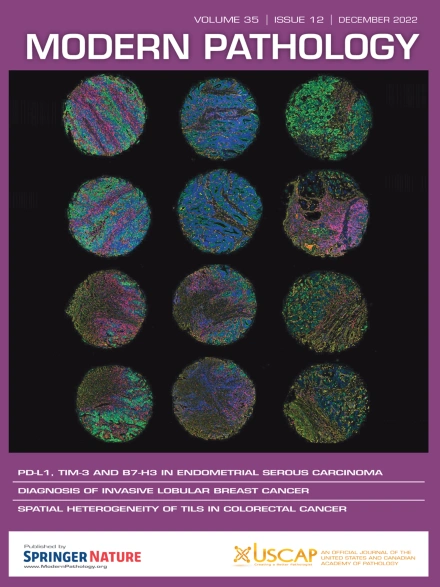Computational Pathology-Enabled Residual Tumor Estimation Is a Prognostic Factor for Overall Survival in Anal Squamous Cell Carcinoma
IF 7.1
1区 医学
Q1 PATHOLOGY
引用次数: 0
Abstract
The incidence of anal squamous cell carcinoma (SCC) has increased, and treatment has shifted from surgery to chemoradiotherapy (CRT), with salvage abdominoperineal resection being reserved for persistent/recurrent cases. This study evaluates the utility of different tumor regression scoring systems in predicting survival in anal SCC patients, using pathologists’ observations and digital pathology. Data of cases managed surgically from 2005 to 2019 were collected. Residual tumor was assessed by multiple methods (gross tumor size, largest focus of tumor on hematoxylin and eosin (H&E) slide, average of residual tumor in all submitted H&E slides, Japanese Esophageal Society, Chirieac, Schneider, Hermann, and College of American Pathologists scoring system). Three expert pathologists individually estimated (“eyeballed”) the residual tumor percentage based on residual tumor/tumor bed (single representative H&E slide). The QuPath software was used to measure tumor volume on the same slide. The American Joint Committee on Cancer eighth staging and outcome data were retrieved from electronic medical records. The study involved 48 participants, predominantly female (56%), with a median age of 57 years. Most were Caucasian. Human papillomavirus-positive was present in 77% of those assessed (17/22). Initial treatment included CRT, followed by abdominoperineal resection (79%) or pelvic exenteration (21%). Complications (13%), persistent disease (33%), and recurrence (54%) led to surgical interventions. Fifty-one percent had moderately differentiated SCC, whereas 42% were poorly differentiated. Lymphovascular invasion (44%), perineural invasion (38%), and lymph node metastasis (13%) were present. Distant metastasis was rare (2%). Median overall survival was 3.2 years. Positive margins (hazard ratio, 4.12; 95% CI, 1.83-9.28) and larger tumor size (hazard ratio, 1.02; 95% CI, 1.01-1.03) were associated with an increased hazard of death. Most residual tumor measurement methods were not significantly associated with overall survival. Interobserver agreement (based on “eyeballing”) was moderate (kappa, 0.4). Computational pathology-based residual tumor percentage was the only method significantly associated with outcome, with each 10% increase in the residual tumor percentage corresponding to a 1.23-fold higher hazard death (95% CI, 1.03; 1.46; P = .024). This study highlights computational pathology’s important role in predicting outcomes in anal SCC treated with CRT and surgery. Specifically, the computational assessment of the residual tumor percentage proves to be a strong predictor of overall survival, outperforming other established tumor regression scoring systems methods.
计算病理学支持的残余肿瘤估计是肛门鳞状细胞癌总生存的预后因素。
肛门鳞状细胞癌(SCC)的发病率已经增加,治疗已经从手术转向放化疗(CRT),保留腹会阴切除术(APR)用于持续/复发病例。本研究利用病理学家的观察和数字病理学,评估了不同肿瘤回归评分系统(TRSS)在预测肛门鳞状细胞癌患者生存方面的效用。收集2005 - 2019年手术处理病例。采用多种方法(肿瘤总大小、肿瘤在H&E切片上的最大病灶、所有提交的H&E切片中残余肿瘤的平均值、JES、Chirieac、Schneider、Hermann、CAP评分系统)评估残余肿瘤。三位病理学专家分别根据残留肿瘤/肿瘤床(单张代表性H&E切片)估算(“目测”)残留肿瘤%。使用QuPath软件测量同一张载玻片上的肿瘤体积。美国癌症联合委员会(AJCC)第8期,结果数据从电子病历中检索。该研究涉及48名参与者,主要是女性(56%),中位年龄为57岁。大多数是白种人。77%的被评估者(17/22)存在hpv阳性。初始治疗包括放化疗(CRT),随后进行APR(79%)或盆腔切除(21%)。并发症(13%)、持续性疾病(33%)和复发(54%)导致手术干预。51%为中分化SCC, 42%为低分化SCC。存在淋巴血管侵犯(44%)、神经周围侵犯(38%)和淋巴结转移(13%)。远处转移罕见(2%)。中位总生存期为3.2年。阳性切缘(HR 4.12, 95% CI 1.83, 9.28)和较大的肿瘤大小(HR 1.02, 95% CI 1.01, 1.03)与死亡风险增加相关。大多数残留肿瘤测量方法与总生存率无显著相关性。观察者间一致性(基于“眼球观察”)为中等(kappa 0.4)。基于计算病理学的残余肿瘤百分比是唯一与预后显著相关的方法,残余肿瘤百分比每增加10%对应的危险死亡增加1.23倍(95% CI 1.03, 1.46;p = 0.024)。本研究强调了计算病理学在预测肛门SCC CRT和手术治疗结果中的重要作用。具体来说,残余肿瘤百分比的计算评估被证明是总生存的一个强有力的预测指标,优于其他已建立的TRSS方法。
本文章由计算机程序翻译,如有差异,请以英文原文为准。
求助全文
约1分钟内获得全文
求助全文
来源期刊

Modern Pathology
医学-病理学
CiteScore
14.30
自引率
2.70%
发文量
174
审稿时长
18 days
期刊介绍:
Modern Pathology, an international journal under the ownership of The United States & Canadian Academy of Pathology (USCAP), serves as an authoritative platform for publishing top-tier clinical and translational research studies in pathology.
Original manuscripts are the primary focus of Modern Pathology, complemented by impactful editorials, reviews, and practice guidelines covering all facets of precision diagnostics in human pathology. The journal's scope includes advancements in molecular diagnostics and genomic classifications of diseases, breakthroughs in immune-oncology, computational science, applied bioinformatics, and digital pathology.
 求助内容:
求助内容: 应助结果提醒方式:
应助结果提醒方式:


